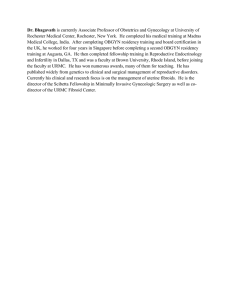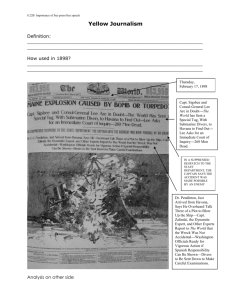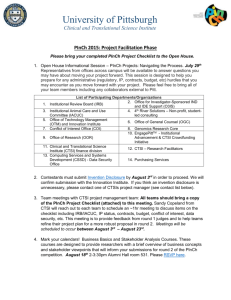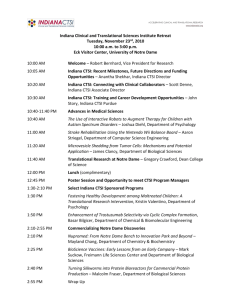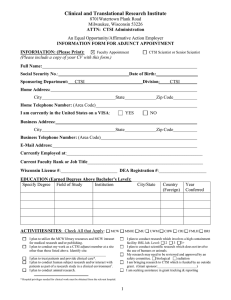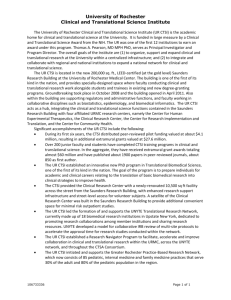Notes to File: An Auditor`s Perspective Disclaimers
advertisement
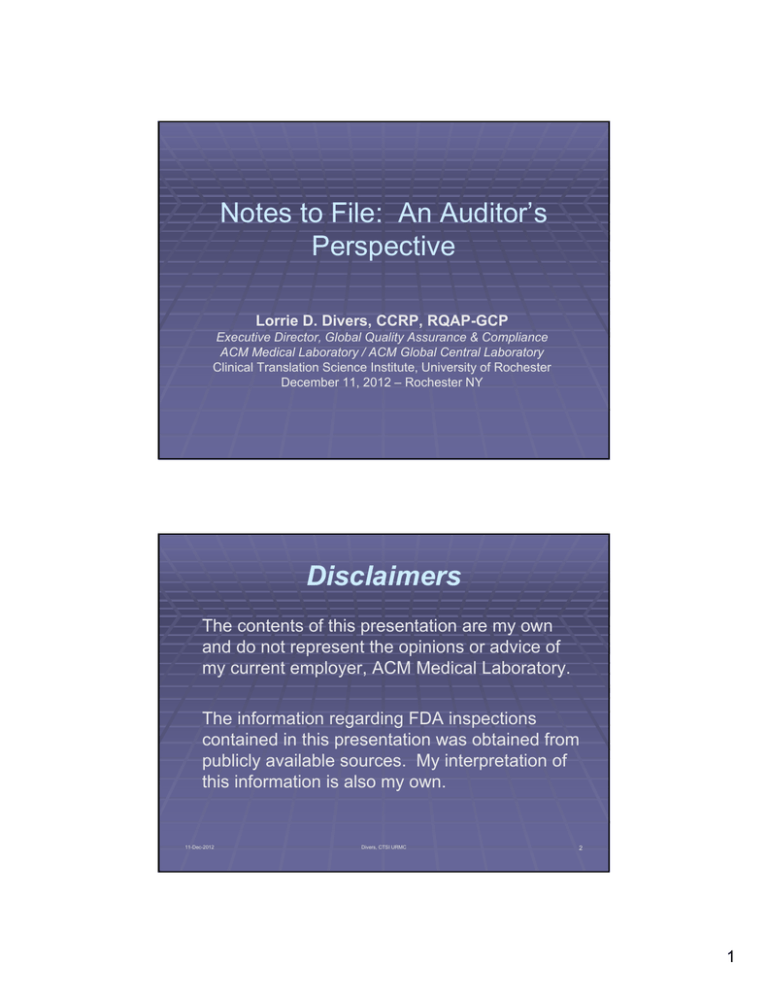
Notes to File: An Auditor’s Perspective Lorrie D. Divers, CCRP, RQAP-GCP Executive Director, Global Quality Assurance & Compliance ACM Medical Laboratory / ACM Global Central Laboratory Clinical Translation Science Institute, University of Rochester December 11, 2012 – Rochester NY Disclaimers The contents of this presentation are my own and do not represent the opinions or advice of my current employer, ACM Medical Laboratory. The information regarding FDA inspections contained in this presentation was obtained from publicly available sources. My interpretation of this information is also my own. 11-Dec-2012 Divers, CTSI URMC 2 1 Objectives The Paper Tells (or Doesn’t Tell) the Story Critical role of documentation in the conduct of clinical trials Whose Documentation Is It, Anyway? Sites, Sponsors or the FDA? How to Keep Your Nightmare from Becoming an Auditor’s Dream Come True! Corrective and Preventive Actions 11-Dec-2012 Divers, CTSI URMC 3 The Paper Tells the Story If it isn’t documented… How it’s documented matters too! 11-Dec-2012 Divers, CTSI URMC 4 2 The Paper Tells the Story Source documentation is a regulatory responsibility of clinical investigators 21 CFR 312.62, Investigator recordkeeping and record retention “…adequate and accurate case histories that record all observations and other data pertinent to the investigation…” including documentation of informed consent Disposition of drug(s) Progress reports and Safety reports Financial disclosure 11-Dec-2012 Divers, CTSI URMC 5 The Paper Tells the Story 21 CFR 812.140(a) – “…accurate, complete, and current records…” including: Correspondence (IRB, FDA, other investigators, sponsor, monitors) Receipt, use or disposition of device “…each subject’s case history and exposure to the device…” including adverse device effects, documentation of informed consent Required reports (unanticipated adverse effects, progress, deviations, final report) 11-Dec-2012 Divers, CTSI URMC 6 3 Paper that Doesn’t Tell the Story Documentation is frequently cited as inadequate during FDA inspections For the past 10 years, the second most common observation cited by CDER FDA inspectors Others include: Failure to follow the protocol/investigational plan Failure to account for disposition of study drugs Failure to report Adverse Events Inadequate subject protection – including informed consent issues 11-Dec-2012 Divers, CTSI URMC 7 Paper that Doesn’t Tell the Story “For the Month 6 visit, the subject apparently visited the office on two different days, 10/6/03 and 10/7/03. A note to file dated 6/8/04 states that page 2 of the source document for the visit done on 10/7/03 is missing and indicates that the physical exam was not done because you were not in the office….By contrast, a note written on 10/6/03 by a different study coordinator states that all appropriate procedures were done except for a biopsy because the physician had to leave the office.” [Source: Jan 21, 2009; Stewart] 11-Dec-2012 Divers, CTSI URMC 8 4 The Paper Tells the Story How the paper tells the story is equally important Inaccurate or incomplete records Late entries Improper corrections Inappropriate personnel completing Electronic records 21 CFR Part 11 FDA Guidance: Computerized Systems Used In Clinical Investigations, May 2007 Draft guidance on Electronic Source Data in Clinical Investigations, November 2012 11-Dec-2012 Divers, CTSI URMC 9 ALCOA principles for GDP Attributable: Appropriately signed, initialed, dated, (who wrote it when) Legible: No hieroglyphics; properly corrected One line through, add new information, initial and date Contemporaneous: Documented in proximity to occurrence, not 6 months later Original: If not, why not? Certified copies Accurate: Correct subject; sensible dates; modifications clearly explained if not self-evident 11-Dec-2012 Divers, CTSI URMC 10 5 Whose Documentation Is It? Investigator responsibilities Regulatory requirements Sponsor / Monitor expectations 11-Dec-2012 Divers, CTSI URMC 11 Whose Documentation Is It? Source documentation is a regulatory responsibility of clinical investigators Can delegate authority but not responsibility Delegation of authority log with printed name, signature, initials, roles, date(s) involved Appropriately trained, qualified and supervised No appearance of falsification or fraud 11-Dec-2012 Divers, CTSI URMC 12 6 Whose Documentation Is It? “Our investigation indicates that you permitted individuals to conduct study tasks which they had not been delegated the authority to execute, and that your supervision of personnel to whom you delegated study tasks was not adequate to ensure that the clinical trials were conducted according to the signed investigator statement, the investigational plan, and applicable regulations, and in a manner that protected the rights, safety, and welfare of human subjects.” [Source: Feb. 17, 2009; Chappel] 11-Dec-2012 Divers, CTSI URMC 13 Whose Documentation Is It? Just one example: “There were entries made on subject source documents long after those documents were created that provided information concerning the results of adverse events, concomitant medication assessments, alcohol and smoking habits, and/or study drug dosing. However, there is no documentation concerning from where or when this information was obtained.” [Source: Feb. 17, 2009; Chappel] 11-Dec-2012 Divers, CTSI URMC 14 7 Whose Documentation Is It? Sponsors’ expectations regarding source documentation FDA Guideline for the Monitoring of Clinical Investigations, January 1988 “A sponsor is responsible for assuring that data submitted to FDA in support of safety and effectiveness of a test article are accurate and complete. The most effective way to assure the accuracy of data submitted to FDA is to review individual subject records and other supporting documents and compare those records with the reports prepared by the investigator for submission to the sponsor.” 11-Dec-2012 Divers, CTSI URMC 15 Whose Documentation Is It? Source data verification “All information in original records and certified copies of original records of clinical findings, observations, or other activities in a clinical trial necessary for the reconstruction and evaluation of the trial.” [ICH E6, 1.51] Note the new draft guidance definition is identical, adding, “Source data are contained in source documents (original records or certified copies).” Site’s normal record-keeping practices Study-specific source worksheets 11-Dec-2012 Divers, CTSI URMC 16 8 Source Documentation Normal record-keeping versus source worksheets What are the investigator’s / site’s routine records? Source worksheets should supplement, not substitute for or duplicate, source data Normal clinical documentation ≠ clinical research recordkeeping but if normal documentation is adequate, using different documentation is risky An Auditor’s Perspective: What if there are only source worksheets? 11-Dec-2012 Divers, CTSI URMC 17 Source Documentation An Auditor’s Perspective: “In addition to the standard office chart, [sponsor’s] monitors required the completion of study specific source templates that were bound separately from [PI’s] office chart. Some data may be recorded in either chart or both depending on the visit and the testing required. This complicates the data verification process and may increase the probability of transcription errors.” 11-Dec-2012 Divers, CTSI URMC 18 9 Source Documentation Monitors are individuals (so are auditors) Some things are clear regulatory requirements Other elements are subject to interpretation Past experiences may impact current thinking Impact of Monitor personnel changes Consider keeping monitoring visit notes Please speak up! – it is your source documentation 11-Dec-2012 Divers, CTSI URMC 19 An Auditor’s Perspective The same note to file appeared in a number of study subjects’ records as a copy It contained information that conflicted with what the clinical investigator stated during an interview The site staff indicated that they were instructed by a monitor to write the note to file to address a protocol requirement They completed the note to file, the PI signed it, and it was copied for placement in several subjects’ records even though they knew the information was not entirely accurate 11-Dec-2012 Divers, CTSI URMC 20 10 The Paper Tells the Story Documentation is how auditors and inspectors determine how the study was conducted Help them just turn the pages…. Accurate, complete documentation of all aspects of the study illustrates regulatory and protocol compliance 11-Dec-2012 Subject records IRB records Drug or device accountability Informed consent AE / SAE reporting Correspondence Divers, CTSI URMC 21 An Auditor’s Perspective Notes to file documenting The ongoing AE of bilateral conjunctivitis The ongoing AE of headaches “Adverse event follow-up was done” The treating physician was not present when the study medication was dispensed (this was a protocolrequirement) [x 8] The CA Bill of Rights was not signed until Visit 3 [x 4] “All the memos to file generated and collected at this visit have the incorrect site number. Please resolve this discrepancy” 11-Dec-2012 Divers, CTSI URMC 22 11 Nightmares and Dreams The controversies Mistakes are human The solutions? 11-Dec-2012 Divers, CTSI URMC 23 NTF Nightmares and Dreams From ‘Note to Self: No More Notes to File’ by Carl Anderson, Applied Clinical Trials, March 2008 “A common document at many clinical sites is the memo or note to file (NTF). When used properly, an NTF can be a positive practice. Some in the clinical trials community, however, seem to think an NTF is a panacea for all things that have gone wrong. Make a mistake? Then write an NTF…” 11-Dec-2012 Divers, CTSI URMC 24 12 ‘Note to Self: No More Notes to File’ “The practice has become so ubiquitous that new CRAs and study coordinators sometimes think that they are a regulatory requirement…. During my own auditing experience, I have noticed that NTFs are frequently a contentious issue between monitors and study staff…. [some] have developed a habit of writing NTFs instead of developing good recordkeeping practices. All [such an] NTF accomplishes is documenting poor performance. And ineffective work seldom impresses the FDA.” [Carl Anderson] 11-Dec-2012 Divers, CTSI URMC 25 Bad Documentation Practices An Auditor’s perspective How poor practices often lead to the need for retrospective notes to file “Late entries are sometimes made without adequate documentation by the person making the entry including the time and date the entry was made. In addition, the actual source of the late entry is not always evident.” “Progress notes occasionally had multiple date stamps, or were undated, making it difficult to determine the date the exam was actually performed. Some changes are not dated or initialed by the person(s) making the change.” 11-Dec-2012 Divers, CTSI URMC 26 13 Nightmares … Retrospective “documentation” is a very risky practice Warning letter issued to Sanofi-Aventis in October, 2007 “Our investigation found that Aventis failed to take any action to secure compliance while the study was ongoing except to generate numerous memos to file after all subjects had completed the study.” 11-Dec-2012 Divers, CTSI URMC 27 Sanofi-Aventis, October, 2007 “According to an FDA interview with an Aventis manager involved with study 3014, these memos to file served as a mechanism to train the investigator. However, this same Aventis manager conceded that because the majority of these memos to file were generated after all subjects had completed the study, there wasn’t much value in training the clinical investigator. We note that generation of numerous memos to file after all subjects have completed the study does not adequately secure compliance of an investigator.” 11-Dec-2012 Divers, CTSI URMC 28 14 Nightmares … From a Warning Letter issued to a clinical investigator “We note that there were no medical histories in these subjects’ research files. For subjects [-] you created Memos to File stating that medical records were not obtained due to subjects’ primary care physicians being located in Mexico. These memos do not sufficiently address the issue of the missing medical histories. Without the medical histories…it is not possible to verify if the subjects met inclusion criteria for the study.” [Source: June 30, 2008; Hsueh] 11-Dec-2012 Divers, CTSI URMC 29 Nightmares … Just documenting errors without Examining the cause of the problem Explaining the remediation Being necessary Notes to file that are Poorly and/or inaccurately written Frequent and repetitive 11-Dec-2012 Divers, CTSI URMC 30 15 … and Dreams Notes to file written to correct, clarify, or add to the existing source documentation can be effective if they are Well-written – clear and accurate Relevant – appropriate level of detail Infrequent – and not repetitive Timely – not written the day before an audit or inspection 11-Dec-2012 Divers, CTSI URMC 31 Nightmares and Dreams Notes to file are “flags” for auditors and inspectors Prompt us to look at processes and procedures related to the issue documented Prompt us to ask more specific questions Tell us a “story” about the conduct of the study, including about the monitoring 11-Dec-2012 Divers, CTSI URMC 32 16 Nightmares … An Auditor’s Perspective: “A deviation was noted for this subject. Prednisone (steroid) and Ketek (antibiotic) [disallowed medications] were prescribed to the subject by an outside doctor during the study. Dr. [PI] did not know the subject was taking these medications until Visit 3.” What procedures do you think this NTF would prompt an auditor to explore? 11-Dec-2012 Divers, CTSI URMC 33 … and Dreams There is no expectation of perfection Clinical trials are conducted, monitored and audited by human beings Effective use of Notes to File Demonstrate GCP compliance and GDP by documenting corrective and preventive actions (CAPA) 11-Dec-2012 Divers, CTSI URMC 34 17 Corrective and Preventive Actions 11-Dec-2012 Divers, CTSI URMC 35 Nightmares … “Documenting a mistake means absolutely nothing during an FDA inspection. What requires documentation is the corrective action taken and whether the action worked.” From ‘Note to Self: No More Notes to File’ by Carl Anderson, Applied Clinical Trials, March 2008 11-Dec-2012 Divers, CTSI URMC 36 18 … and Dreams Correct the source of problem / error / non-compliance and prevent future problems Start with root cause analysis The 5 why’s of a problem Then develop effective resolutions SOPs Checklists Remedial training Internal audits 11-Dec-2012 Divers, CTSI URMC 37 CAPA – Root Cause When a mistake or an error or an incident of non-compliance occurs, evaluate why What was the actual mistake? Hint: It may not be what it appears to be Under what circumstances did it occur? Who was involved? When was the error detected and how? What were the consequences? Were subjects’ safety, rights or welfare impacted? 11-Dec-2012 Divers, CTSI URMC 38 19 An Auditor’s Perspective - The Problem “A significant number of signed Consent Forms have date and signature anomalies made both by subjects and study personnel.” Date(s) changed – with or without time changing In several instances, changed by several days, weeks, or in one case, by more than a month Two instances of subject signing on “Person obtaining consent line.” One instance was lined through, one remained uncorrected Often not dated by subject and/or PI themselves but obviously by someone else 11-Dec-2012 Divers, CTSI URMC 39 An Auditor’s Perspective - The Reason(s) What is really happening here? Was this just random human error? From visit to visit, monitoring needs to connect the dots – “Haven’t I seen this mistake before?” Root cause analysis Correct the real problem: Realistically, do people get the date wrong by several days or a month, or does the signature date change but not the time? Informed Consent process issues illustrated by the pattern of errors 11-Dec-2012 Divers, CTSI URMC 40 20 How to Develop CAPA Once you have defined the problem, how can you develop corrective and preventive actions? Be SMART Specific, Measurable, Attainable, Relevant, Time-bound/Trackable Be clear and precise Avoid extraneous information, obfuscation, defensive remarks Describe how the action will be implemented 11-Dec-2012 Divers, CTSI URMC 41 An Auditor’s Perspective - The Problems First 8 subjects enrolled 3 mis-randomizations 4 improperly signed ICFs Next 10 subjects enrolled 3 mis-randomizations All 10 ICFs/assents incorrectly signed Next 21 subjects enrolled Two adults signed child assent forms 2 mis-randomizations Multiple instances of disallowed concomitant meds and/or improper use of study drug 11-Dec-2012 Divers, CTSI URMC 42 21 An Auditor’s Perspective - The Non-Solutions “[The PI] was asked to closely follow the protocol instructions regarding obtaining and documenting the informed consent process with future subjects. [The PI] was asked to submit all protocol deviations to the IRB.” “The PI and SC were advised of these protocol deviations and verbalized their understanding.” “A note to file will be written to explain the discrepancies.” 11-Dec-2012 Divers, CTSI URMC 43 CAPA Don’t just take the PI / study staff / or the monitor’s word for it Investigate the root cause In a manual system, occasional / rare randomization errors may be possible but 6 of the first 18 subjects is not rare Correct the cause of the error, don’t just document it Lack of controlled process: Poorly organized supplies and improper use of the accountability log 11-Dec-2012 Divers, CTSI URMC 44 22 Notes to File – Tips and Techniques 11-Dec-2012 Divers, CTSI URMC 45 Notes to File – Tips and Techniques For a retrospective Note to File: Define the problem What is the root cause? Evaluate the impact of it Subject safety? Data integrity? Administrative? How can it be corrected? What actions does the investigator need to take? Documentation and follow-up What needs to occur to prevent it from happening again? Does investigator/site staff training or behavior need to be addressed? 11-Dec-2012 Divers, CTSI URMC 46 23 Example of an Effective NTF “As noted during the site initiation visit 1/15/08, the site does not use the Sponsor provided temperature log found in the Regulatory Binder. The site’s standard temperature log maintained on the side of the refrigerator where culture medium is stored contained the necessary information. At the first monitoring visit 2/29/08, it was noted that the temperatures were not logged on Saturdays and Sundays. SC and Monitor confirmed with ACM 2/29/08 that culture medium remains acceptable for use up to 48 hours at room temperature and a closed refrigerator is not likely to reach room temperature for at least several hours. The site staff will check and document refrigerator temperatures first thing Monday AM and last thing Friday PM. Culture medium will be discarded and re-ordered if any temperature anomalies are suspected. This plan was discussed with and approved by ACM and Sponsor Project Management.” 11-Dec-2012 Divers, CTSI URMC 47 What Notes to File Cannot Do A note to file, in and of itself, does not Correct Prevent Secure compliance Appropriately escalate non-compliance Correction / compliance is an action / behavior Training Monitoring Auditing 11-Dec-2012 Divers, CTSI URMC 48 24 What You Can Do Practice good documentation practices from the start of the study ALCOA Document errors and their correction in a timely manner Recognize patterns and consider the story they tell Make CAPA a habit, including assessing effectiveness Understand the protocol and GCP requirements and investigator responsibilities Ask questions of the monitor, sponsor, PI, IRB, auditors Checkout the FDA website 11-Dec-2012 Divers, CTSI URMC 49 We’re all in this together! 11-Dec-2012 Divers, CTSI URMC 50 25 Questions 11-Dec-2012 Divers, CTSI URMC 51 Contact Information Lorrie D. Divers, CCRP, RQAP-GCP 585-429-2386 LDivers@acmgloballab.com “Quality is never an accident; it is always the result of high intention, sincere effort, intelligent direction and skillful execution; it represents the wise choice of many alternatives.” Willa A. Foster 11-Dec-2012 Divers, CTSI URMC 52 26
